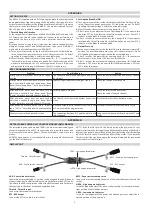
a
Yeti Tandem 3 user manual
aa
_________________________________________________________________________________________________________________________________
a
a
Summary: "Active
fl
ying"
●
The pilot sits upright in his harness, his view goes in the direction of the
fl
ight.
●
He constantly responds to increasing and decreasing brake pressures with the aim of
maintaining a constant pressure on the brake lines.
●
The further in front of you the glider pitches, the larger the brake input required, but for a
shorter duration.
●
When brake pressures decrease, brake
fi
rmly; when brake pressures increase, ease off
the brakes.
}
}
Rapid descent techniques
a
Many
fl
ying situations call for a very rapid descent to avoid a dangerous situation, e.g. the up
current from a cumulus cloud, an approaching cold front or a storm front.
Rapid descent methods should all be practised in calm conditions and at su
ffi
cient altitude so
that a pilot is then able to employ them effectively if extreme conditions arise. Rapid descent
techniques are divided into three different manoeuvres which increase the sink rate in a safe and
controllable manner.
Big ears and spiral dives are generally the most common methods of descent. Big ears can
achieve a moderate rate of descent with the advantage of forward speed and manoeuvrability.
Spiral dives attain higher rates of descent, but the g-forces can be signi
fi
cant and the
manoeuvre is more technically demanding. ‘B-stalls’ have little or no advantages compared to
the other methods of descent and therefore are not recommended in normal situations. Always
try to avoid the need to use these descent techniques. Thoroughly check the conditions before
launch, and pay close attention to how the day develops.
All of these options will also strain your paraglider and should be avoided if you want to
preserve your paraglider. We recommend that you practice the rapid descent techniques under
professional guidance during a safety training course.
}
The spiral dive is the most effective method for making a rapid descent, and can allow sink rates
of up to 20 m/s to be reached. It is suitable where there is a high ascent rate and little wind.
The Yeti Tandem 3 ful
fi
ls the EN spiral dive requirements and has no tendency to remain in a
stable spiral dive under normal conditions. The certi
fi
cation test
fl
ights are carried out with a
de
fi
ned carabiner distance (see chapter "Harness"). Deviations from this setting, unapproved
harnesses or spirals with excessive sink can change the maneuver considerably; pilot action may
be required. In such cases, exit the spiral by weight shifting to the outside and progressively
applying the outside brake.
Before entering a spiral, make sure you have adequate height for recovery. To enter the spiral
dive, weight shift and progressively apply the inside brake until the glider enters the spiral. As the
glider accelerates into the spiral, centre your weight and control your rate of descent with weight
shift and outer brake.
ǧ
ǧ
ǧ
Page 17
a
Summary of Contents for Yeti Tandem 3
Page 1: ...v2 0 October 2020...
Page 52: ...www gingliders com...
















































